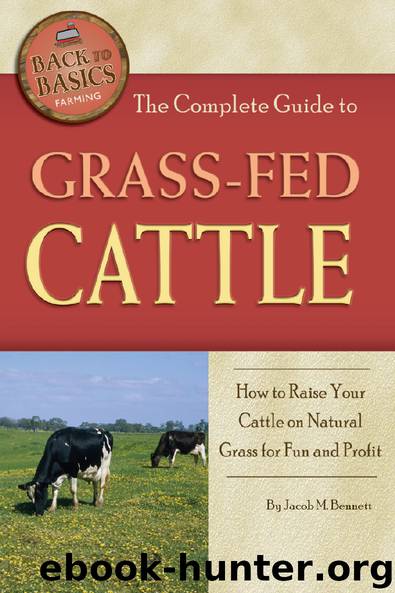The Complete Guide to Grass-Fed Cattle: How to Raise Your Cattle on Natural Grass for Fun and Profit by Jacob Bennett

Author:Jacob Bennett
Language: eng
Format: epub
Tags: grass feed, cattle, raise, natural, feed, care, farming, milk, meat, livestock, soil, crops, breeding, heredity, requirements
Publisher: Atlantic Publishing
Published: 2012-03-06T00:00:00+00:00
Udder Anatomy
Dairy farmers should understand how the udder works because the udder is the factory for all dairy products because it produces milk, butterfat, and protein. The udder is four teats and a sack divided into two front and two rear quarters. From behind, you can see it is divided in half by an indentation called the mammary groove. The teats, at the ends of each quarter, are release valves for milk for suckling calves. They are smooth and hairless. The duct through which milk exits is called the streak canal, which relaxes during milking to allow milk release. Using a germicidal postmilking solution on the teats will help keep bacteria from invading in the several minutes before the duct closes. The solution will also keep flies away. A strong suspensory system of ligaments and tendons provide support and keep the udder in proper alignment with the body. If this supporting structure breaks down, the cow is more prone to teat or udder injury and more susceptible to the udder infection called mastitis. Mastitis will be discussed in more detail later in the chapter.
The udder has a vast vascular system. Large mammary arteries are located on the side of the udders. Ducts and cisterns, storage areas for fluids inside the udder, drain the milk from the secretory tissues, which make up the majority of the udder.
The process of releasing milk into the udder is called milk letdown. It is brought about through the release of a hormone called oxytocin at the base of the cow’s brain. Oxytocin affects the muscle cells surrounding the udder’s milk, which causes them to contract. This squeezes the milk out of the cells and into the milk ducts that drain to the teat. Stimulate the release of oxytocin by gently massaging the udder for 15 seconds. This will cause the teats to fill with milk within a couple of minutes. Cattle need to be calm during milking or they may not release oxytocin. Stressed cattle release adrenaline, which blocks oxytocin for up to 30 minutes. This decreases milk yield and leads to milk retention, another cause of mastitis.
Download
This site does not store any files on its server. We only index and link to content provided by other sites. Please contact the content providers to delete copyright contents if any and email us, we'll remove relevant links or contents immediately.
Craft Beer for the Homebrewer by Michael Agnew(18200)
Marijuana Grower's Handbook by Ed Rosenthal(3648)
Barkskins by Annie Proulx(3336)
Project Animal Farm: An Accidental Journey into the Secret World of Farming and the Truth About Our Food by Sonia Faruqi(3192)
The Plant Messiah by Carlos Magdalena(2900)
Red Famine: Stalin's War on Ukraine by Anne Applebaum(2894)
0041152001443424520 .pdf by Unknown(2820)
Organic Mushroom Farming and Mycoremediation by Tradd Cotter(2662)
In the Woods by Tana French(2562)
Beer is proof God loves us by Charles W. Bamforth(2420)
7-14 Days by Noah Waters(2389)
Borders by unknow(2282)
Reservoir 13 by Jon McGregor(2267)
Meathooked by Marta Zaraska(2239)
The Art of Making Gelato by Morgan Morano(2234)
Between Two Fires by Christopher Buehlman(2225)
Birds, Beasts and Relatives by Gerald Durrell(2198)
The 7 Habits of Highly Effective People: Powerful Lessons in Personal Change (25th Anniversary Edition) by Covey Stephen R(2171)
The Lean Farm Guide to Growing Vegetables: More In-Depth Lean Techniques for Efficient Organic Production by Ben Hartman(2107)
